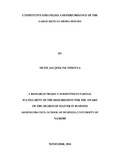| dc.description.abstract | Competitive strategy is about achieving competitive advantage over competitors.
Ideally, the firm should seek to try to achieve some position that is difficult or
impossible for rivals to imitate. The essence of formulating competitive strategy is
relating a company to its environment. Although the relevant environment is very
broad, encompassing social as well as economic forces, the key aspect of firms
environment is the industry or the industry it competes with. Industry structure has a
strong influence in determining the competitive rules of the game as well as the
strategies potentially available to the firm. Forces outside the firm are significant
primarily in a relative sense; since outside forces usually affect all firms in the
industry, the key is found in the differing ability of firms to deal with them. Media
industry in Kenya has witnessed exponential growth with creation of more radio
stations, television channels, newspapers and magazines. The users benefit from a
drop in prices and a concomitant rise in quality. Mobile and internet services have
enabled journalists to easily access information. This has increased pressure on
competition among the media houses compelling managers of media houses to set
some strategies to enable them survive the changing media competition environment.
This study sought to determine the competitive strategies used by the large Kenyan
media houses and their effectiveness in improving the performance of the media
houses. This was achieved through a cross sectional research. Data was collected
using questionnaires distributed to the media staff in the six largest media houses in
Kenya. The data was coded and analysed using descriptive statics which included
mean standard deviation, percentages and frequencies. Inferential statistics were also
used by the researcher to test the correlation and the effect of the strategies on the
performance of the media houses. The study found that adopting competitive
strategies improved the performance of the media houses. The strengthening of
internal control systems, optimizing prices, speedy delivery of information, tailoring
promotions and segmenting markets were effective in improving the performance of
the media houses. Large Kenya media houses that adopt intensive competitive
strategies tend to have superior performance despite the dynamic media industry, so
there is a positive relationship between pursuing competitive strategies and the
performance of the large Kenyan media houses. The pricing strategy and the type of
market affect the performance of the media houses hence the regulatory bodies have
to monitor the operations of the media houses. The study provides empirical support
for the resource based view, that performance of firm lies in the application of the
resources available at firms disposal and adds more knowledge on the Open system
theory which holds that firms are strongly influenced by the external environment.
The study recommended that managers in the media houses employ clear processes
which prevent unwarranted losses in the media houses. The study also recommended
that more training be done to the media staff to catch up with the changing
technologies and new ways of doing broadcast. | en_US |

